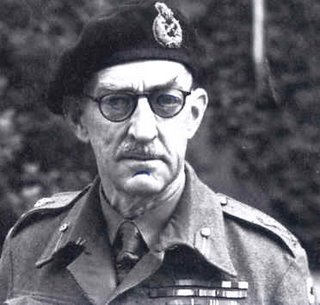Sir Percy.

This is coolbert:
Here is an interesting web site. Deals with the career of British General Sir Percy Claghorn Hobart [love that name, Claghorn].
British military commander in the years between World War One [WW1] and World War Two [WW2] who was instrumental in the development of armored units within the British Army.
Hobart was following the precepts of armored warfare as written about by Fuller and Basil Liddell-Hart.
Precepts that differed markedly from the type of armored warfare as was practiced in WW1.
Ideas and precepts that were innovative and even revolutionary for their time.
The ideas of Fuller and Liddell-Hart were to have self-contained armored units that would operate in a manner reminiscent of the Mongol armies of seven centuries earlier. Units that could move cross-country unimpeded by any terrain, self-sufficient, living off the land, wreaking havoc where ever they went.
"Liddell Hart held that tanks would restore to 20th-century warfare the ancient Mongolian idea of extreme mobility -- the Mongols' main instrument of conquest."
"Where the Mongols lived off the country through which they ranged, Hobart planned to carry sustaining rations in the tanks. Refueling would be from lightly-protected dumps in the enemy rear, where the far-ranging armored columns would penetrate and strike. He worked with relentless zeal to cut "the tail" of non-fighting service vehicles which hobbled and almost immobilized conventional army units. Tank forces of the future were to be self-contained for the maximum possible range."
What is said about the Mongols, however, is NOT quite right. The horde [ordu], on the march, was ponderous, only able to move four to five miles a day.
And there is good reason. The horde consisted not ONLY of warriors on horseback, but considerable impedimenta.
This impedimenta included:
* Wives and children of the Mongol warriors. Whole families were on the march.
* Herds of war ponies, camels, sheep. Each warrior had four to five pony remounts. Camels [bactrian [??] were prized for providing dung that was used as a valuable source of fuel [campfires], and mutton from sheep was the Mongol favorite meal.
[The horde if nothing else resembled a moving stockyard.]
* The pavilion of the great Khan. Mounted on a platform with wheels, and pulled by twenty oxen.
It is true that a Mongol tuman, a divisional size unit of about 10,000 horsemen, COULD move up to 100 miles a day, WHEN MOVING TO BATTLE. At that point, the tuman would cast off impedimenta and DID live off the land. But was NOT expected to do so forever.
The Mongols were a profoundly destructive and effective military force, but WERE NOT super-men.
The use of extreme mobility is something that an APC [M113] equipped unit for the Ghurkha Brigade of my thought experiment would also utilize.
From the web site, some interesting observations about Hobart:
* At age 55, after being retired from active duty, Hobart served as a CORPORAL in the British Home Guard [1940]. From General officer to CORPORAL??!!
* He was the brother-in-law of Field Marshal Bernard Law Montgomery.
coolbert.
Labels: English.

0 Comments:
Post a Comment
Subscribe to Post Comments [Atom]
<< Home